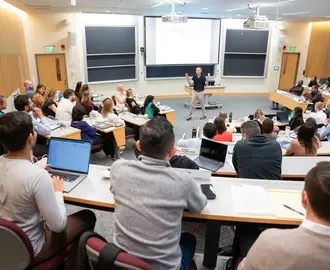By Cleidy Liborio Fernandes, EMBA '22
T=0 is an equation I learned at MIT. It so profoundly inspired my journey that I decided to get it tattooed on my wrist.
T=0 means “Time is now.” Nothing short of a perpetual self-reminder that there is no better moment than the present to get involved, to act, to be innovative and entrepreneurial. Or, in my case, intrapreneurial.
Cleidy Liborio Fernandes, EMBA '22
MIT gifted me new lenses to see that innovation does not only happen between the walls of a startup. Brutally speaking, I had no excuse for waiting to come up with the greatest start-up idea or genius invention to make the world a better place—time is now!
To stay true to MIT Sloan’s mission, to be “a principled, innovative leader who improves the world,” I needed to start with something within my reach. As Professor Nelson Repenning framed during Organizations Lab (O-Lab), to tackle large problems, we must start with small changes.
In other words, my idea of executing was to design effective leadership skills to enable intrapreneurship in a very large international organization. Transforming entrepreneurial concepts into intrapreneurial, I had to start with my team—the people I interact with every day. Simple, right?
Not quite.
I wondered what effective leadership meant and pondered, how does one become intrapreneurial while working in one of the oldest industries in the world, all while getting others engaged in these ideas.
As an avid and passionate learner, I sought answers by absorbing as much knowledge as I could. In addition to the already demanding MBA program, I completed three additional certificates offered by MIT: Entrepreneurship & Innovation, Business Analytics, and Sustainability (Disclosure: applying to all of them is highly inadvisable for one’s sanity’s sake and yes, I would do it all over again). Later, I realized the magic was not in the volume of information, but how quickly one can implement change and experiment these new learnings to solidify knowledge.
Let me start by saying: I really love my team. They are an incredibly resilient group of people. Together, we drive the commercial strategy of 40 countries in addition to a diverse range of departments, from data analytics to sustainability and from commercial to pricing of specialized products. There’s no such thing as a boring day—our time is filled with various topics from operational matters to negotiation strategies. In our world everything can impact our tactics, and consequently our strategy, so the ability to pivot it key.
I find it impossible to pinpoint one crucial moment or learning in the program that shaped the way I see the world today. It happened by connecting the dots between the myriad of lectures, classes, and studies that I was exposed to during the entire MIT Executive MBA program. And of course, the invaluable learnings from my classmates—lifelong friends whom I care deeply for—is a beautiful bonus to the entire experience.
Having the advantage of managing different departments, I could apply the constructs and concepts from Professor Ancona’s research on x-teams together with the idea of distributive leadership. During her course, Discovering Your Leadership Signature, we learned to identify individual capabilities that prompt success in high performing teams—sensemaking, relating, visioning, inventing, and building credibility—the model known as “4-CAP+ Leadership.”
The very first principle of x-teams is “seeking out before in,” which means reaching outside the team to find information, navigating politics, engaging outside sponsors for new ideas and working beyond the limits of the department.
The learnings resonated immediately with my personal values. It brought up the importance of respect for each team member, enabling autonomy while seeking knowledge from each other and outside sources. Lastly, the institution of a learning mindset. In our team, we are always asking ourselves, what did we learn from a particular project or situation? How could we have done it better? It became a habit.
In Communication and Persuasion with Data, Senior Lecturer Miro Kazakoff exposed why our expertise gets in the way of being a more effective communicator, giving us tools for the continuous improvement of our foundations in order communicate clearly. He reminded us that communication is a process of encoding, transmitting, and decoding information between people.
The progression of choosing the ideas and representing them in light and sound, so they can be transmitted and decoded by the recipient. Although it’s a simple concept to understand, many good ideas fail due to poor communication, as every mind decodes it differently. The learnings challenged us to use metacognition, the process of thinking about one's own thinking and learning experience—often called “extreme rigor when reviewing our presentations” by my team (I’ll just give them a pass for that). Critical cognitive skills are essential for leadership in general, but vital in a commercial organization.
Finally, I cannot end without mentioning Senior Lecturer Bridget Akinc, who alluded to the shopping cart theory during the Leading with Impact module. The theory stuck with me ever since. Even more so after I mentioned it during our class graduation speech, which I had the honor of delivering.
Bridget reminded us that to return the shopping cart is an easy task that everyone can recognize as the right thing to do. No one will punish you for not returning it, you gain nothing by doing it. It doesn’t come with thanks, nor any recognition. It takes a bit of our time and may get us a little dirty, but it makes the world a better place. It makes the system run better. It’s a very small effort from one person which, if not done, will make it much harder for the person who must pick up after us and push 15 or 20 of them. Team members should always help each other.
Start with small changes to make the world a better place. Seek out before in, to innovate. Think about the thinking of others. Know when to let go. Be kind.
T=0.
Related Posts



